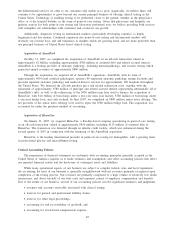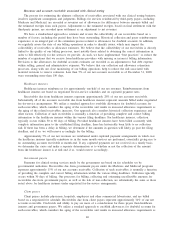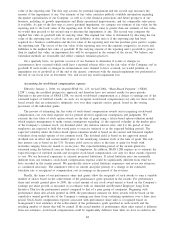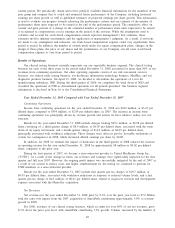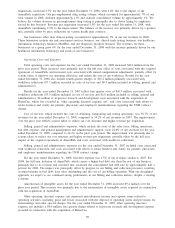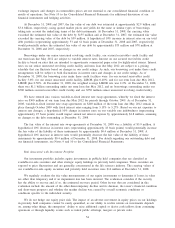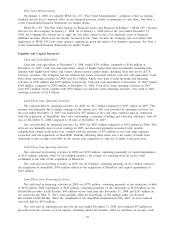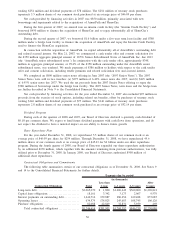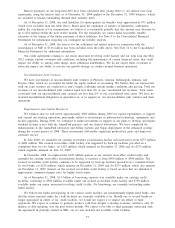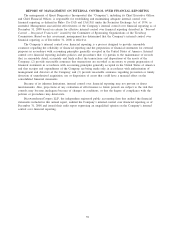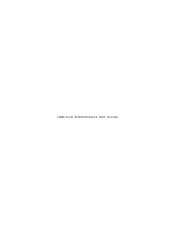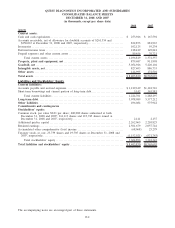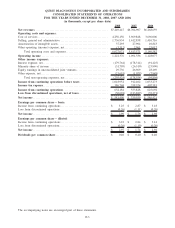Quest Diagnostics 2008 Annual Report Download - page 65
Download and view the complete annual report
Please find page 65 of the 2008 Quest Diagnostics annual report below. You can navigate through the pages in the report by either clicking on the pages listed below, or by using the keyword search tool below to find specific information within the annual report.with efforts to retain business and clarify for patients, physicians and employers misinformation regarding the
UNH contract change; and the impact of the acquired operations of AmeriPath and HemoCue.
For the year ended December 31, 2007, bad debt expense was 4.5% of net revenues, compared to 3.9% in
the prior year period. The increase was principally driven by the inclusion of AmeriPath, which carries a higher
bad debt rate than the rest of our business, primarily due to its revenue and customer mix, and by higher bad
debt expense associated with billing patients directly for a portion of the UNH volume.
Other operating (income) expense, net represents miscellaneous income and expense items related to
operating activities, including gains and losses associated with the disposal of operating assets and provisions for
restructurings and other special charges. For the year ended December 31, 2007, other operating (income)
expense, net included a $4.0 million charge related to in-process research and development expense recorded in
connection with the acquisition of HemoCue. For the year ended December 31, 2006, other operating (income)
expense, net included pre-tax charges of $27 million, principally associated with integration activities related to
LabOne and our operations in California.
Operating Income
Operating income for the year ended December 31, 2007 was $1.1 billion, or 16.3% of net revenues,
compared to $1.1 billion, or 18.0% of net revenues, in the prior year period. The decrease in operating income as
a percentage of net revenues was principally due to lower volume levels in our clinical testing business, the
various items which served to increase cost of services and selling, general and administrative expenses as a
percentage of revenues, and the impact of the acquired operations of AmeriPath and HemoCue. These decreases
were offset in part by actions we have taken to reduce our cost structure and higher revenue per requisition.
Other Income (Expense)
Interest expense, net for the year ended December 31, 2007 increased $87 million over the prior year. The
increase in interest expense, net was primarily due to additional interest expense associated with borrowings to
fund acquisitions, as described more fully in Note 9 to the Consolidated Financial Statements.
Other expense, net represents miscellaneous income and expense items related to non-operating activities
such as gains and losses associated with investments and other non-operating assets. For the year ended
December 31, 2007, other expense, net includes a $4 million charge related to the write-down of an investment.
For the year ended December 31, 2006, other expense, net includes $26 million of charges related to the write-
downs of investments partially offset by a gain of $16 million on the sale of an investment.
Discontinued Operations
In connection with the investigation of NID, which is described earlier, during the third quarter of 2007, the
government and the Company began settlement discussions. In the course of those discussions, the government
disclosed to the Company certain of the government’s legal theories regarding the amount of damages allegedly
incurred by the government, which include alleged violations of civil and criminal statutes including the False
Claims Act and the Food, Drug and Cosmetics Act. Violations of these statutes and related regulations could lead
to a warning letter, injunction, fines or penalties, exclusion from federal healthcare programs and/or criminal
prosecution, as well as claims by third parties. The Company analyzed the government’s position and presented
its own analysis which argued against many of the government’s claims. In light of that analysis and based on
the status of settlement discussions, the Company established a reserve, in accordance with generally accepted
accounting principles, reflected in discontinued operations, of $241 million in connection with these claims. See
Note 14 and Note 15 to the Consolidated Financial Statements for a further description of these matters.
Loss from discontinued operations, net of tax, for the year ended December 31, 2007 was $214 million, or
$1.10 per diluted share, compared to $39 million, or $0.20 per diluted share in 2006. Results for the year ended
December 31, 2007 reflect a charge of $241 million to establish a reserve as described above. Results for the
year ended December 31, 2006 reflect pre-tax charges of $32 million, primarily related to the wind down of
NID’s operations.
Quantitative and Qualitative Disclosures About Market Risk
We address our exposure to market risks, principally the market risk of changes in interest rates, through a
controlled program of risk management that may include the use of derivative financial instruments. We do not
hold or issue derivative financial instruments for trading purposes. We believe that our exposures to foreign
53




